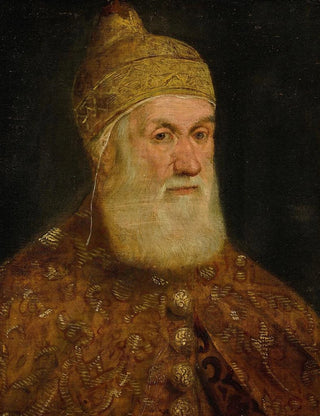Art print | Portrait of Doge Girolamo Priuli - Jacopo Tintoretto


View from behind

Frame (optional)
Portrait of Doge Girolamo Priuli - Jacopo Tintoretto – Captivating Introduction
The "Portrait of Doge Girolamo Priuli" by Jacopo Tintoretto is much more than a simple depiction of a man in a position of power. It is an open window into Venice of the 16th century, a time when art and politics were deeply intertwined. This painting, imbued with psychological depth and rich in detail, invites the viewer to immerse themselves in the complex universe of the doge and his era. Priuli's imposing stature, accentuated by dramatic lighting, evokes both respect and awe. As you contemplate this work, you can almost feel the breath of history, as if Tintoretto had succeeded in capturing not only the image but also the soul of his subject.
Style and uniqueness of the work
Tintoretto's style is distinguished by its boldness and ability to play with light and shadow. In this art print, striking contrasts highlight the features of the doge, while creating an atmosphere of mystery. The color palette, dominated by rich and deep tones, enhances the majesty of the character. Every detail, from the fabric of the robe to the ornaments, is executed with remarkable precision, demonstrating the artist's talent for conveying the luxury and grandeur of Venetian nobility. The expression of the doge, both stoic and contemplative, suggests a complex personality, a man aware of the challenges of his role. This work, through its unique style, transcends the simple portrait to become a true statement on power and responsibility.
The artist and his influence
Jacopo Tintoretto, an emblematic figure of the Venetian Renaissance, is recognized for his ability to combine impeccable technique with artistic innovation. His bold approach to composition and light influenced many artists of his time and subsequent generations. Tintoretto did not merely reproduce reality; he sought to express emotions and narratives through his works. The "Art print of Doge Girolamo Priuli" is a perfect example, where each brushstroke seems to tell a story. By tackling historical and religious subjects with dramatic intensity, Tint

Matte finish

View from behind

Frame (optional)
Portrait of Doge Girolamo Priuli - Jacopo Tintoretto – Captivating Introduction
The "Portrait of Doge Girolamo Priuli" by Jacopo Tintoretto is much more than a simple depiction of a man in a position of power. It is an open window into Venice of the 16th century, a time when art and politics were deeply intertwined. This painting, imbued with psychological depth and rich in detail, invites the viewer to immerse themselves in the complex universe of the doge and his era. Priuli's imposing stature, accentuated by dramatic lighting, evokes both respect and awe. As you contemplate this work, you can almost feel the breath of history, as if Tintoretto had succeeded in capturing not only the image but also the soul of his subject.
Style and uniqueness of the work
Tintoretto's style is distinguished by its boldness and ability to play with light and shadow. In this art print, striking contrasts highlight the features of the doge, while creating an atmosphere of mystery. The color palette, dominated by rich and deep tones, enhances the majesty of the character. Every detail, from the fabric of the robe to the ornaments, is executed with remarkable precision, demonstrating the artist's talent for conveying the luxury and grandeur of Venetian nobility. The expression of the doge, both stoic and contemplative, suggests a complex personality, a man aware of the challenges of his role. This work, through its unique style, transcends the simple portrait to become a true statement on power and responsibility.
The artist and his influence
Jacopo Tintoretto, an emblematic figure of the Venetian Renaissance, is recognized for his ability to combine impeccable technique with artistic innovation. His bold approach to composition and light influenced many artists of his time and subsequent generations. Tintoretto did not merely reproduce reality; he sought to express emotions and narratives through his works. The "Art print of Doge Girolamo Priuli" is a perfect example, where each brushstroke seems to tell a story. By tackling historical and religious subjects with dramatic intensity, Tint






